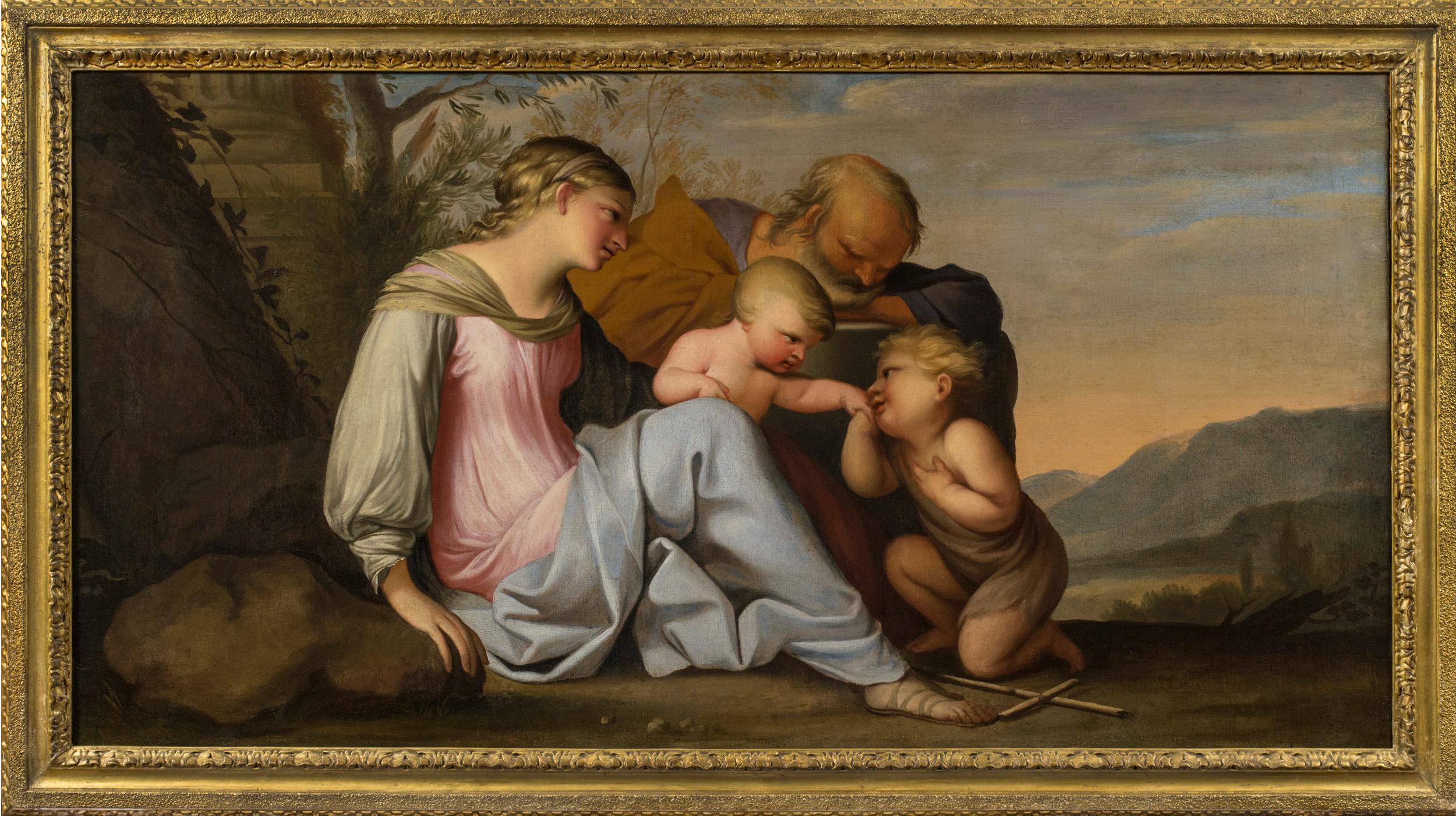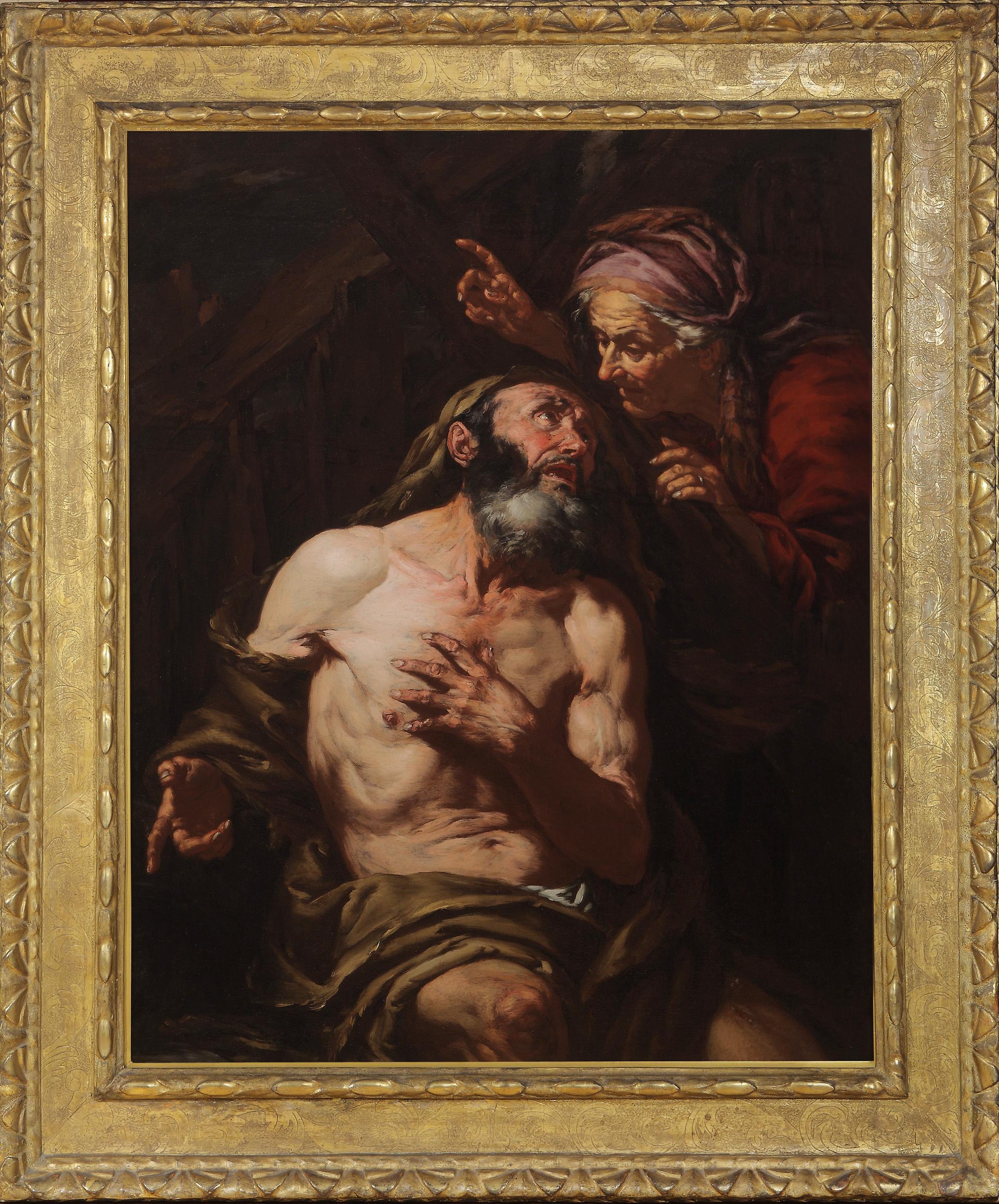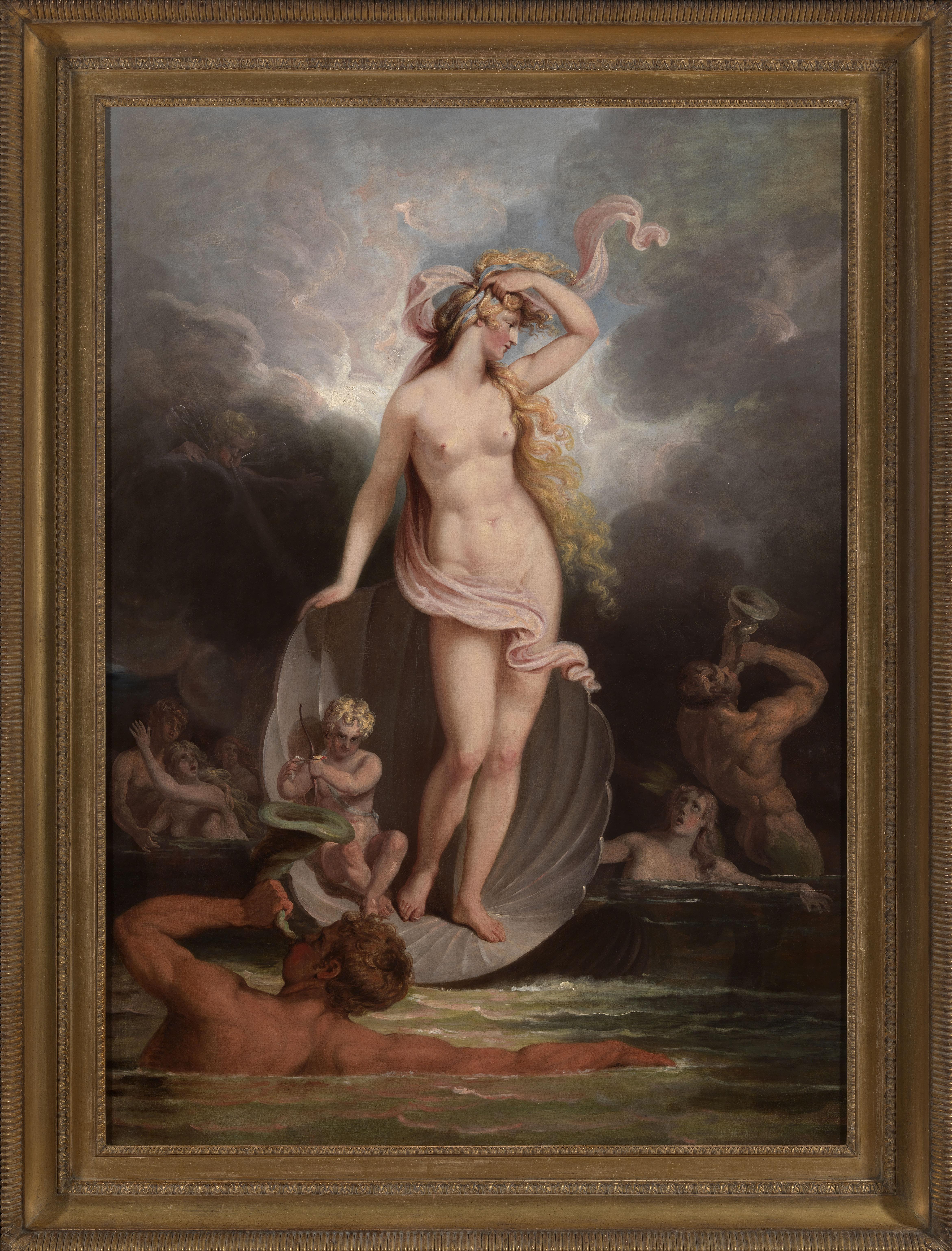Items Similar to Nicolas de Largillière - Portrait of a Lady, Paris, circa 1695
Want more images or videos?
Request additional images or videos from the seller
1 of 11
Nicolas de LargillièreNicolas de Largillière - Portrait of a Lady, Paris, circa 1695circa 1695
circa 1695
About the Item
Nicolas de Largillière (Paris, 1656-1746)
Portrait of a lady, circa 1695
Oil on canvas (relined): 76 x 61 cm
Framed: h. 97 cm, l. 82 cm
To be included in the forthcoming catalogue raisonné of the artist by Dominique Brême, director of museum of Sceaux and artist specialist.
Our work presents a majestic French aristocrat against the backdrop of a twilight landscape.
The face seen from the front, the body turned three-quarters, the young woman is portrayed half-length, revealing her slim belted waist.
The elongated face with rosy cheeks, almond-shaped eyes, straight nose and strong chin, solemn expression, the young woman sketches in a half-smile which brings out the dimple on her chin. Its white, milky complexions are worked in glaze and display a transparency and an almost tangible velvety.
Hair styled "a la Fontange", her powdered hair is raised and tied with a pink ribbon, the two curls frame the forehead and the mass of curly locks fall on her back and shoulders. A jewel is housed in her high bun.
She is dressed in a silver and shimmering silk dress over a white shirt whose lace is revealed at the level of the bodice.
A loose coat of pink satin with orange tones envelops her figure animated by angular folds of the crumpled fabric.
The fiery sparkles of the pink fabric clash with the frosty reflections of the silver satin. By juxtaposing the opposing colours, the painter accentuates the contrast. The fiery reflection of pink is reflected in the corset like fire in a mirror. This breathtaking effect bears witness to the great ingenuity of Nicolas de Largillière, this daring handling of the palette in the wake of Antoine Van Dyck.
This extremely intense chromatic range contrasts with the sober background of the classic landscape with a darkened sky.
The almost electric light of the theatrical staging accentuates the whiteness of skin tones and the brilliance of fabrics.
The virtuosity of the painter shines in the treatment of fabrics, the effects of scintillation, the spontaneity in the rendering of the texture because the care given to the clothes is as important in the art of the portrait as the model itself.
The young unknown not only gives us the image of a fresh and desirable young woman in full bloom of youth and beauty.
Accentuated by a tight framing, the presence of our model gains in intensity.
Our portrait, the reflection of an elegant and refined society, is seductive by its striking effect, associating the prodigious talent of the painter with the grace and natural beauty of the model.
In the absence of any distinctive sign on our painting, the identity of our noble lady remains unknown.
Our portrait will be included in the catalog raisonné of the work of Nicolas de Largillierre, currently being prepared by Mr. Dominique Brême, director of the museum of the Domaine départemental de Sceaux and specialist in the artist.
Nicolas de Largillière (Paris, 1656-1746)
Nicolas de Largilliere, born October 2, 1656 in Paris, where he died March 20, 1746, is a French painter. Of Flemish origin although born in Paris, he spent his childhood in Antwerp apprenticed to the landscape painter Antoine Goubau. In 1673 he went to England where he worked as an assistant in the studio of the portrait painter Peter Lely for several years. Largillierre discovers the art of portraiture in London and assimilates the beautiful lessons of the British successor of Antoine van Dyck. On his return to France, he was admitted to the Royal Academy in 1683 and three years later was received as a "painter of portraits and history" on presentation of the Portrait of Charles Le Brun.
He is one of the most famous portrait painters of the 17th and 18th centuries. Nicolas de Largillière's long career spanned the reigns of Louis XIV and Louis XV, during which he established himself as a leading portrait painter. His female effigies, in particular, strike by their introspective character and their decorative richness.
- Creator:Nicolas de Largillière (1656 - 1746, French)
- Creation Year:circa 1695
- Dimensions:Height: 38.19 in (97.01 cm)Width: 32.28 in (82 cm)
- Medium:
- Movement & Style:
- Period:1690-1699
- Condition:Very good original condition, cleaned and revarnished by our professionnal art restorer.46000.
- Gallery Location:PARIS, FR
- Reference Number:1stDibs: LU2433214036422
About the Seller
No Reviews Yet
Vetted Seller
These experienced sellers undergo a comprehensive evaluation by our team of in-house experts.
1stDibs seller since 2023
- ShippingRetrieving quote...Ships From: PARIS, France
- Return PolicyA return for this item may be initiated within 3 days of delivery.
More From This SellerView All
- Late 17th century portrait of a French princess, daughter of Louis XIVBy Pierre GobertLocated in PARIS, FRPortrait of Françoise Marie de Bourbon, Duchess of Orléans as Venus A magnificent painting depicting the princess in all the splendour of her youth, Françoise Marie de Bourbon, known...Category
Late 17th Century Old Masters Figurative Paintings
MaterialsCanvas, Oil
- Louis XIV and his army at the crossing of the Rhine by Adam-Frans van der MeulenBy Adam Frans van der MeulenLocated in PARIS, FRAdam-Frans van der Meulen (Bruxelles, 1632 - Paris, 1690) Louis XIV and his army at the crossing of the Rhine 12 June 1672 Signed A.F VANDERMEULEN at the right low corner Oil on can...Category
1670s Old Masters Landscape Paintings
MaterialsCanvas, Oil
- Jean-Marc Nattier (1685 - 1766) - Portrait of Charlotte de Hesse-RheinfelsBy Jean-Marc NattierLocated in PARIS, FRJean-Marc Nattier (Paris, 1685 - 1766) and his workshop Portrait of Charlotte de Hesse-Rheinfels Oil on canvas : h. 44.09 in, w. 38.19 in 18th century carved giltwood framed Fra...Category
1730s Old Masters Figurative Paintings
MaterialsCanvas, Oil
- A 17th c. Italian school, Capriccio with the Colosseum, circle of V. CodazziLocated in PARIS, FRA capriccio with the Colosseum in Roma 17th century Italian school Circle of Viviano Codazzi (1604-1670) Oil on canvas Dimensions: h. 35.43 in, w. 51.18 in Modern 17th century style ...Category
17th Century Old Masters Landscape Paintings
MaterialsCanvas, Oil
- Cercle of Ambrosius Francken, Adoration of the shepherds, 17th century AntwerpLocated in PARIS, FRAdoration of the shepherds, Cercle of Ambrosius Francken, Early 17th century Antwerp school Oil on oak panel: h. 55 cm, w. 43 cm (21.65 in x 16.93 in) 17th c. ebonized and moulded f...Category
Early 17th Century Old Masters Figurative Paintings
MaterialsOil, Wood Panel
- Adam and Eve in paradise, studio of Jan Brueghel the Younger, 17th centuryLocated in PARIS, FRStudio of Jan Brueghel the Younger 17th century Antwerp school Oil on oak panel, h. 37 cm, w. 49 cm Tortoiseshell veneered baroque style frame...Category
Mid-17th Century Old Masters Figurative Paintings
MaterialsOil, Wood Panel
You May Also Like
- Italian 18th Century Oval Religious Oil on Canvas Painting with Saint DominicBy Francesco de MuraLocated in Firenze, ITThis beautiful Italian 18th Century old masters oil painting on oval canvas with giltwood frame is attributed to Solimena and features a religious scene. In this splendid oval-shaped painting are depicted Saint Dominic...Category
18th Century Old Masters Figurative Paintings
MaterialsOil, Canvas
- Head of an AngelLocated in New York, NYProcaccini was born in Bologna, but his family moved to Milan when the artist was eleven years old. His artistic education was evidently familial— from his father Ercole and his elder brothers Camillo and Carlo Antonio, all painters—but his career began as a sculptor, and at an early age: his first known commission, a sculpted saint for the Duomo of Milan, came when he was only seventeen years old. Procaccini’s earliest documented painting, the Pietà for the Church of Santa Maria presso San Celso in Milan, was completed by 1604. By this time the artist had made the trip to Parma recorded by his biographers, where he studied Correggio, Mazzola Bedoli, and especially Parmigianino; reflections of their work are apparent throughout Procaccini's career. As Dr. Hugh Brigstocke has recently indicated, the present oil sketch is preparatory for the figure of the angel seen between the heads of the Virgin and St. Charles Borrommeo in Procaccini's altarpiece in the Church of Santa Afra in Brescia (ill. in Il Seicento Lombardo; Catalogo dei dipinti e delle sculture, exh. cat. Milan 1973, no. 98, pl. 113). As such it is the only known oil sketch of Procaccini's that can be directly connected with an extant altarpiece. The finished canvas, The Virgin and Child with Saints Charles Borrommeo and Latino with Angels, remains in the church for which it was painted; it is one of the most significant works of Procaccini's maturity and is generally dated after the artist's trip to Genoa in 1618. The Head of an Angel is an immediate study, no doubt taken from life, but one stylistically suffused with strong echoes of Correggio and Leonardo. Luigi Lanzi, writing of the completed altarpiece in 1796, specifically commented on Procaccini's indebtedness to Correggio (as well as the expressions of the angels) here: “Di Giulio Cesare...Category
17th Century Old Masters Figurative Paintings
MaterialsCanvas, Paper, Oil
- An Architectural Capriccio with the Preaching of an ApostleBy Giovanni Paolo PaniniLocated in New York, NYProvenance: Santambrogio Antichità, Milan; sold, 2007 to: Filippo Pernisa, Milan; by whom sold, 2010, to: Private Collection, Melide, Switzerland De Primi Fine Art, Lugano, Switzerland; from whom acquired, 2011 by: Private Collection, Connecticut (2011-present) Literature: Ferdinando Arisi, “Ancora sui dipinti giovanili del Panini,” Strenna Piacentina (Piacenza, 2009): pp. 48, 57, 65, fig. 31, as by Panini Ferdinando Arisi, “Panini o Ghisolfi o Carlieri? A proposito dei dipinti giovanili,” Strenna Piacentina, (Piacenza, 2010), pp. 100, 105, 116, fig. 101, as an early work by Panini, a variant of Panini’s painting in the Museo Cristiano, Esztergom, Hungary. This architectural capriccio is one of the earliest paintings by Giovanni Paolo Panini, the preeminent painter of vedute and capricci in 18th-century Rome. The attribution to Panini has been endorsed by Ferdinando Arisi, and a recent cleaning of the painting revealed the artist’s signature in the lower right. Like many of his fellow painters working in Rome during his day, Panini was not a native of the Eternal City. He first trained as a painter and stage designer in his hometown of Piacenza and moved to Rome at the age of 20 in November 1711 to study figure painting. Panini joined the workshop of Benedetto Luti (1666-1724) and from 1712 was living on the Piazza Farnese. Panini, like many before and after him, was spellbound by Rome and its classical past. He remained in the city for the rest of his career, specializing in depicting Rome’s most important monuments, as well as creating picturesque scenes like this one that evoked the city’s ancient splendor. The 18th century art historian Lione Pascoli, who likely knew Panini personally, records in his 1730 biography of the artist that when Panini came to Rome, he was already “an excellent master and a distinguished painter of perspective, landscape, and architecture.” Panini’s earliest works from this period still show the evidence of his artistic formation in Piacenza, especially the influence of the view painter Giovanni Ghisolfi (1623-1683). However, they were also clearly shaped by his contact in Rome with the architectural capricci of Alberto Carlieri...Category
18th Century Old Masters Figurative Paintings
MaterialsCanvas, Oil
- Holy Family with the Infant St. John the BaptistLocated in New York, NYLubin Baugin (Pithiviers 1610 – 1663 Paris) Holy Family with the Infant Saint John the Baptist Oil on canvas 22 x 42 ¼ inches (55.9 x 107.3 cm) Provenance: Marcello and Carlo ...Category
17th Century Old Masters Figurative Paintings
MaterialsCanvas, Oil
- Job Cursed by His WifeBy Giovanni Battista LangettiLocated in New York, NYProvenance: Alfred (1883-1961) and Hermine Stiassni (1889-1962), Brno, Czech Republic, by 1925; thence London, 1938-1940; thence Los Angeles, 1940-1962; thence by descent to: Susanne Stiassni Martin and Leonard Martin, San Francisco, until 2005; thence by descent to: Private Collection, California Exhibited: Künstlerhaus, Brünn (Brno), 1925, as by Ribera. “Art of Collecting,” Flint Institute of Art, Flint, Michigan, 23 November 2018 – 6 January 2019. Literature: Alte Meister...Category
1670s Old Masters Paintings
MaterialsCanvas, Oil
- 18th century allegorical painting of The Triumph of BeautyLocated in London, GBExhibited: London, Royal Academy, 1800, no. 93 What was happening in British history painting in around 1800? In recent discussions of the emergence of a British School of history painting following the foundation of the Royal Academy in 1768, this is a question which is rarely posed and one which is not easily answered. Examination of surviving Royal Academy exhibition catalogues reveals a profusion of artists’ names and titles, few of which remain immediately recognizable, whilst endeavours to explain the impact of exhibition culture on painting - such as the 2001 Courtauld show Art on the Line - have tended to focus on the first and second generation of Royal Academician, rather than young or aspiring artists in the early nineteenth century. This makes the discovery and identification of the work under discussion of exceptional importance in making sense of currents in English painting around 1800. Executed by Edward Dayes...Category
18th Century Old Masters Figurative Paintings
MaterialsCanvas, Oil




